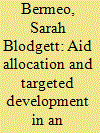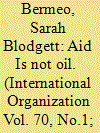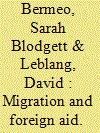| Srl | Item |
| 1 |
ID:
156711


|
|
|
|
|
| Summary/Abstract |
Aid donors pursue a strategy of targeted development with regard to recipient states. The determinants of aid allocation have shifted significantly. Industrialized states are increasingly unable to insulate themselves from spillovers caused by underdevelopment abroad. Donors attempt to use aid to decrease these spillovers, targeting developing countries where the effects on the donor are anticipated to be large. Once a recipient is chosen, concern for recipient government capacity guides the composition of aid. Empirical analysis of aid allocation from 1973 to 2012 demonstrates that, while explanations based on security and economic ties to the donor explain allocation well in the Cold War, the post-2001 period is best understood by incorporating a role for targeted development. This framework helps synthesize various findings in the aid allocation literature and has important implications for studying aid effectiveness.
|
|
|
|
|
|
|
|
|
|
|
|
|
|
|
|
| 2 |
ID:
145008


|
|
|
|
|
| Summary/Abstract |
Recent articles conclude that foreign aid, like other nontax resources, inhibits political change in authoritarian regimes. This article challenges both the negative political effects of aid and the similarity of aid to other resources. It develops a model incorporating changing donor preferences and the heterogeneity of foreign aid. Consistent with the model's predictions, an empirical test for the period 1973–2010 shows that, on average, the negative relationship between aid and the likelihood of democratic change is confined to the Cold War period. However, in the post–Cold War period, nondemocratic recipients of particular strategic importance can still use aid to thwart change. The relationship between oil revenue and democratic change does not follow the same pattern over time or across recipients. This supports the conclusion that aid has different properties than other, fungible, resources.
|
|
|
|
|
|
|
|
|
|
|
|
|
|
|
|
| 3 |
ID:
140352


|
|
|
|
|
| Summary/Abstract |
When it comes to linkages between migration and the global allocation of foreign development assistance, the size of the immigrant population from a recipient country residing in a donor country is an important determinant of dyadic aid commitments. Two complementary hypotheses probe this relationship. First, donors use foreign aid to achieve their broader immigration goals, targeting migrant-sending areas to increase development and decrease the demand for entry into the donor country. Second, migrants already residing in the donor country mobilize to lobby for additional aid for their homeland. Empirical tests on a large sample of country pairs made up of twenty-two donors and more than 150 recipients over the period 1993 to 2008 show robust support for these hypotheses.
|
|
|
|
|
|
|
|
|
|
|
|
|
|
|
|